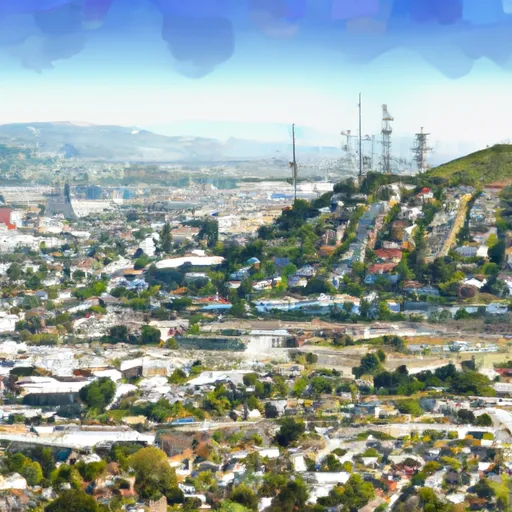-
 Snoflo Premium
Snoflo Premium
Get unlimited access to all our content
With no Ad interruptions! - Start Your Free Trial Login with existing account
Signal-Hill
Eden Index
Climate
8.9
•
Recreation
5.4
•
Community
3.6
•
Safeguard
6.3/10

Signal Hill is a small city located in Los Angeles County, California. Its Mediterranean climate is characterized by mild, wet winters and warm, dry summers. The annual average temperature is around 67°F (19°C), with temperatures rarely exceeding 90°F (32°C) or dropping below 50°F (10°C). Precipitation averages around 13 inches per year, primarily occurring between November and April.
Hydrologically, the city is part of the Los Angeles River watershed. Signal Hill does not have any natural lakes or rivers, but it does have several reservoirs and underground water sources that provide water to the city.
Outdoor enthusiasts will find a range of recreational opportunities in Signal Hill. The city boasts several parks and green spaces, including Hillbrook Park and Discovery Well Park, which offer walking paths, playgrounds, and picnic areas. Nearby, visitors can explore the El Dorado Nature Center, a 105-acre nature preserve with scenic trails, lakes, and wildlife viewing opportunities. Additionally, Signal Hill Park offers sports fields, a skate park, and a community center. With its pleasant climate and various outdoor amenities, Signal Hill provides ample opportunities for residents and visitors to enjoy nature and engage in recreational activities.
What is the Eden Index?
The Snoflo Eden Index serves as a comprehensive rating system for regions, evaluating their desirability through a holistic assessment of climate health, outdoor recreation opportunities, and natural disaster risk, acknowledging the profound impact of these factors on livability and well-being.
Climate Health Indicator (CHI): 8.9
Signal-Hill receives approximately
328mm of rain per year,
with humidity levels near 75%
and air temperatures averaging around
18°C.
Signal-Hill has a plant hardyness factor of
10, meaning
plants and agriculture in this region tend to thrive here all year round.
By considering the ideal temperature range, reliable water supplies, clean air, and stable seasonal rain or snowpacks, the Climate Health Indicator (CHI) underscores the significance of a healthy climate as the foundation for quality living.
A healthy climate is paramount for ensuring a high quality of life and livability in a region, fostering both physical well-being and environmental harmony. This can be characterized by ideal temperatures, reliable access to water supplies, clean air, and consistent seasonal rain or snowpacks.
Weather Forecast
Streamflow Conditions
Ventura-San Gabriel Coastal
Area Rivers
Ventura-San Gabriel Coastal
Snowpack Depths
Ventura-San Gabriel Coastal
Reservoir Storage Capacity
Ventura-San Gabriel Coastal
Groundwater Levels
Recreational Opportunity Index (ROI): 5.4
The Recreational Opportunity Index (ROI) recognizes the value of outdoor recreational options, such as parks, hiking trails, camping sites, and fishing spots, while acknowledging that climate plays a pivotal role in ensuring the comfort and consistency of these experiences.
Access to outdoor recreational opportunities, encompassing activities such as parks, hiking, camping, and fishing, is crucial for overall well-being, and the climate plays a pivotal role in enabling and enhancing these experiences, ensuring that individuals can engage in nature-based activities comfortably and consistently.
Camping Areas
| Campground | Campsites | Reservations | Toilets | Showers | Elevation |
|---|---|---|---|---|---|
| Sunset Vista RV Park | None | 19 ft | |||
| Seabreeze at Seal Beach Military | None | 15 ft | |||
| Gould Mesa | 7 | 1,418 ft | |||
| Bolsa Chica State Beach | 57 | 12 ft | |||
| Los Alamitos Army Military | None | 25 ft | |||
| Devore | 6 | 2,914 ft | |||
| Millard | 5 | 1,980 ft | |||
| Glenn Camp | 8 | 2,095 ft |
Catastrophe Safeguard Index (CSI):
The Catastrophe Safeguard Index (CSI) recognizes that natural disaster risk, encompassing floods, fires, hurricanes, and tornadoes, can drastically affect safety and the overall appeal of an area.
The level of natural disaster risk in a region significantly affects safety and the overall livability, with climate change amplifying these risks by potentially increasing the frequency and intensity of events like floods, fires, hurricanes, and tornadoes, thereby posing substantial challenges to community resilience and well-being.
Community Resilience Indicator (CRI): 3.6
The Community Resilience Indicator (CRI) recognizes that education, healthcare, and socioeconomics are crucial to the well-being of a region. The CRI acknowledges the profound impact of these elements on residents' overall quality of life. By evaluating educational resources, healthcare accessibility, and economic inclusivity, the index captures the essential aspects that contribute to a thriving community, fostering resident satisfaction, equity, and social cohesion.

